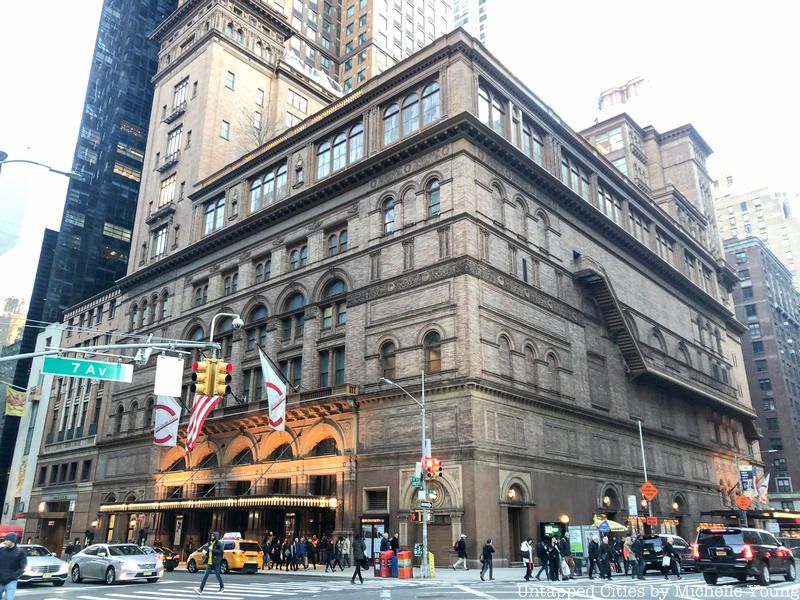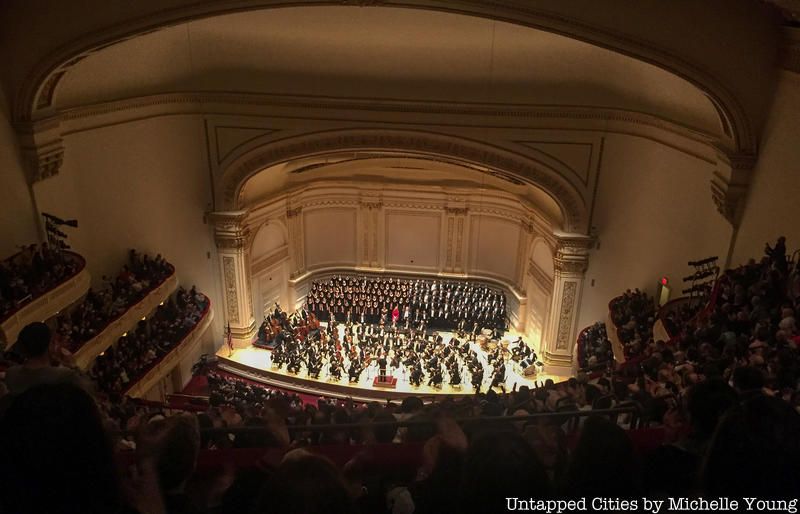NYC’s Forgotten ‘War on Christmas Trees’
Discover how an obscure holiday crackdown affects festive street vendors today!

Did you know the fames concert venue was almost demolished?!

Great musicians and composers from Tchaikovsky to The Beatles have graced the stage at Carnegie Hall since the venue opened in 1891 on the corner of 57th Street and 7th Ave in Midtown Manhattan. For more than 130 years the concert hall has served as a platform for legendary acts and at one point was a literal home to entertainment icons including Marlon Brando, Leonard Bernstein, and more.
In 2014, Carnegie Hall completed an impressive (though initially controversial) renovation to the tune of $230 million. This transformation converted the beloved artist studios, (where those entertainment icons lived), into education facilities. Untapped New York had the opportunity to tour the rooftop garden, studios, and offices with the Design Trust for Public Space when those spaces opened. Carnegie Hall director of administration, Richard Malenka, took us through the history of the famed music hall, imparting many secrets and other gems of information we never knew about before. Here are 10 forgotten facts about Carnegie Hall:
Join Untapped New York Members on December 21st to learn more about Carnegie Hall as we embark on a private tour of the famed venue, with special visits to the Composers' Gallery and Rose Museum where rare musical scores and other historical objects are on display. Tickets are 25% off regular price for Untapped New York Members at the Insider level or higher!

Steel magnate Andrew Carnegie was one of America’s great Gilded Age millionaires (equivalent to being a multi-billionaire today). Carnegie Hall runs as a non-profit today, but when Carnegie’s wife and conductor Walter Damrosch petitioned him to build a concert hall to rival those in Europe, he formed a for-profit music hall company. This decision has had a direct impact on the architecture of Carnegie Hall that survives today, and here’s why.
The original hall had a red tile mansard roof, and the building looked quite different (and shorter) than the hall today. Its acoustics were considered a technological marvel, and the architect William Tuthill, who trained in the office of Richard Morris Hunt, was also an amateur cellist. But despite critical acclaim, Carnegie Hall lost money in its first season in 1891, prompting Carnegie to think of more revenue streams for the building.
By 1894, the mansard roof was removed and two floors inserted for double height loft studios that could be rented, bringing in additional income for the music hall. In addition, a new 12-story building on 56th Street was built.
These additional space were still not enough to cover the operating deficit so in 1896, a new tower was built along 57th Street above the building. Tuthill protested these design changes, feeling his Italianate palazzo masterpiece was being gradually compromised, so Carnegie promptly hired the more renown architect, Henry Hardenbergh (who designed the Plaza Hotel and the Dakota Apartments) to do the new additions, which were designed to more closely match the Italianate style.

When Carnegie Hall was built, the Midtown area was then known as Goat Hill and some in the press decried the location of the hall, saying that nobody would ever go because it was so far uptown. (14th Street at the time was the heart of the entertainment industry). But Carnegie, the Astors and others saw the future and were building in Midtown and even further north. You can see the Dakota (named so for being so far away) rising next to Central Park in the construction photographs of Carnegie Hall.
For the expansion of Carnegie Hall, an existing brewery, built there because of a natural spring on the location, was purchased and demolished.

The Great Depression hit the whole country hard and Carnegie Hall transformed its first floor into storefronts. Sometime after 1895 through the 1900s, there was a large canopy added, which you can see in the above photograph, that stretched out to the street.

There are three music venues inside Carnegie Hall. Besides the main hall, now the Stern Auditorium Perelman Stage, there’s Weill Recital Hall, built as a chamber music hall, and Zankel Hall. From 1900 to 1950, the space that is now Zankel Hall was rented to the American Academy of Dramatic Arts for theatrical productions, after which it became an art house cinema (Cinema Treasures reports that it was screening gay porn in the 1970s! ), and finally a commercial cinema showing indie films run by Cineplex Odeon starting in 1987. Cineplex Odeon gave it a $1.4 million renovation, adding a smaller screening room. The latest renovation and renaming to Zankel Hall took place in the early 2000s, opening in 2003.

Walter Damrosch knew he needed a big name draw for opening night in Carnegie Hall in 1891, and Tchaikovsky was the it-composer of the era. Tchaikovsky conducted five of his pieces and kept a notebook entitled Trip to America that documented his experience in the New World. The Carnegie Hall website reports that this small notebook was discovered in one of Tchaikovksy’s suit pockets after he died with some great musings:
On the first page, he wrote, “Things to ask. Is it safe to drink the water in America? What kind of cigarettes do men smoke in New York City? What kind of hats do they wear? Can I get my laundry done there? Check acoustics of the new music hall.”…
He noted that “in other countries, if somebody comes up to you and they’re nice, you suspect, ‘What do they want?’ Here in America, they don’t want anything. They just want to be nice.”

The bedrock was so dense around Carnegie Hall, that when the subway line was built, builders gave up and decided instead to raise the sidewalk and street level. As a result, the side entrance on the front facade lost the steps you see in the 1895 photograph above.

The original plan for Carnegie Hall was to have a roof garden, all the rage during that time. There were fabulous entertainment venues atop Madison Square Garden, the Hotel Astor and many more locations. It never happened, but in the most recent renovation, a rooftop space was added while protecting the original roof. According to Richard Malenka, three new roofs were built (one to protect the original roof, one temporary for additional protection during construction, and the new roof deck).




The artist studios built by Henry Hardenbergh in the second expansion of Carnegie Hall were built in an more elaborate style, with a more exclusive feeling. It was only later that the studios developed their bohemian reputation. One fun fact is that Leonard Bernstein, who lived in the studios, wrote West Side Story about the gangs in the San Juan Hill neighborhood (now Lincoln Center), which he could see from Carnegie Hall.
Today, a visit to the Carnegie Hall archives, which is built into one of these studios, shows many of the original details of the more elaborate studios, some which included a fireplace and staircases between levels with banisters:


Original seats of Carnegie Hall, now in the archive

Metal radiators in what is now the dining room of the Resnick Education Wing

These steel beams were once inside the mansard roof of Carnegie Hall, transformed into the offices of the non-profit. The trusses, steel plates, and suspension rods are what hold up the engineering of the main hall–there are no columns in the space below.
Like bridges and railroad tracks, the trusses gain strength from their flexibility and are meant to move. The open plan architecture of the new offices highlight the steel frame construction of Carnegie Hall, the same technique that would be applied to the city’s skyscrapers. Today, skylights to the roof deck let in natural light.


The renovation in the Resnick Education Wing is also impressive. A new glass elevator that fits grand pianos was inserted to connect the two previously unconnected wings. The music studios have state of the art sound proofing, are adapted for different instruments, and the original windows were protected by adding a new layer of glass.

Inside the elevator


Yet another example of The New York City that Never Was, Carnegie Hall was slotted for demolition in 1959 (delayed to 1960) after it lost its primary tenant, the New York Philharmonic to Lincoln Center. A 44-story tower was planned, rising from a sunken plaza. The skyscraper would have been reached by a footbridge.
Fortunately, there were various campaigns to save Carnegie Hall, the strongest and most notable by musician Isaac Stern who rallied philanthropist Jacob M. Kaplan and State Senator MacNeil Mitchell to the cause. The City of New York purchased Carnegie Hall, which would be run by a new nonprofit organization called The Carnegie Hall Corporation. This setup continues today.
Subscribe to our newsletter